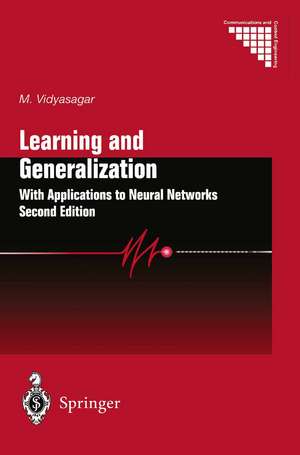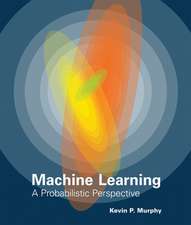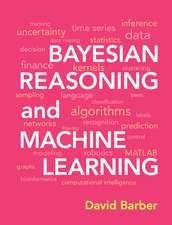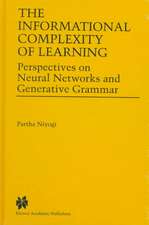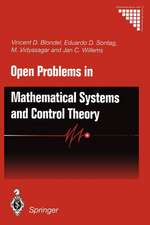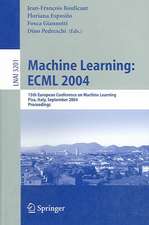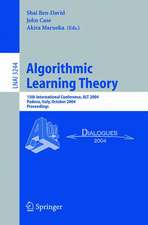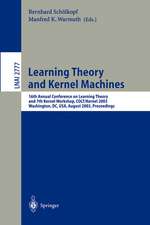Learning and Generalisation: With Applications to Neural Networks: Communications and Control Engineering
Autor Mathukumalli Vidyasagaren Limba Engleză Paperback – 19 oct 2010
• How does a machine learn a concept on the basis of examples?
• How can a neural network, after training, correctly predict the outcome of a previously unseen input?
• How much training is required to achieve a given level of accuracy in the prediction?
• How can one identify the dynamical behaviour of a nonlinear control system by observing its input-output behaviour over a finite time?
The second edition covers new areas including:
• support vector machines;
• fat-shattering dimensions and applications to neural network learning;
• learning with dependent samples generated by a beta-mixing process;
• connections between system identification and learning theory;
• probabilistic solution of 'intractable problems' in robust control and matrix theory using randomized algorithms.
It also contains solutions to some of the open problems posed in the first edition, while adding new open problems.
| Toate formatele și edițiile | Preț | Express |
|---|---|---|
| Paperback (1) | 1117.99 lei 43-57 zile | |
| SPRINGER LONDON – 19 oct 2010 | 1117.99 lei 43-57 zile | |
| Hardback (1) | 1124.15 lei 43-57 zile | |
| SPRINGER LONDON – 27 sep 2002 | 1124.15 lei 43-57 zile |
Din seria Communications and Control Engineering
- 15%
 Preț: 659.70 lei
Preț: 659.70 lei - 20%
 Preț: 879.74 lei
Preț: 879.74 lei - 18%
 Preț: 953.65 lei
Preț: 953.65 lei - 18%
 Preț: 1117.03 lei
Preț: 1117.03 lei - 9%
 Preț: 1385.77 lei
Preț: 1385.77 lei - 18%
 Preț: 1128.08 lei
Preț: 1128.08 lei - 18%
 Preț: 953.65 lei
Preț: 953.65 lei - 15%
 Preț: 656.89 lei
Preț: 656.89 lei - 18%
 Preț: 896.52 lei
Preț: 896.52 lei - 18%
 Preț: 1113.26 lei
Preț: 1113.26 lei - 18%
 Preț: 1388.22 lei
Preț: 1388.22 lei - 15%
 Preț: 647.27 lei
Preț: 647.27 lei - 18%
 Preț: 954.45 lei
Preț: 954.45 lei - 18%
 Preț: 1231.47 lei
Preț: 1231.47 lei - 18%
 Preț: 948.92 lei
Preț: 948.92 lei - 18%
 Preț: 1232.57 lei
Preț: 1232.57 lei - 18%
 Preț: 1127.28 lei
Preț: 1127.28 lei - 15%
 Preț: 643.34 lei
Preț: 643.34 lei - 18%
 Preț: 1401.30 lei
Preț: 1401.30 lei - 15%
 Preț: 651.51 lei
Preț: 651.51 lei - 20%
 Preț: 1454.07 lei
Preț: 1454.07 lei - 18%
 Preț: 948.79 lei
Preț: 948.79 lei - 18%
 Preț: 1233.06 lei
Preț: 1233.06 lei - 18%
 Preț: 947.85 lei
Preț: 947.85 lei - 18%
 Preț: 950.96 lei
Preț: 950.96 lei - 18%
 Preț: 956.99 lei
Preț: 956.99 lei - 15%
 Preț: 644.18 lei
Preț: 644.18 lei - 18%
 Preț: 946.87 lei
Preț: 946.87 lei - 18%
 Preț: 951.14 lei
Preț: 951.14 lei - 18%
 Preț: 961.55 lei
Preț: 961.55 lei - 15%
 Preț: 644.18 lei
Preț: 644.18 lei - 20%
 Preț: 990.80 lei
Preț: 990.80 lei - 18%
 Preț: 1006.72 lei
Preț: 1006.72 lei - 18%
 Preț: 942.44 lei
Preț: 942.44 lei - 18%
 Preț: 1233.06 lei
Preț: 1233.06 lei - 15%
 Preț: 641.85 lei
Preț: 641.85 lei - 18%
 Preț: 957.75 lei
Preț: 957.75 lei - 15%
 Preț: 649.87 lei
Preț: 649.87 lei - 18%
 Preț: 958.07 lei
Preț: 958.07 lei - 18%
 Preț: 1395.94 lei
Preț: 1395.94 lei - 18%
 Preț: 781.62 lei
Preț: 781.62 lei - 18%
 Preț: 953.20 lei
Preț: 953.20 lei - 18%
 Preț: 1109.78 lei
Preț: 1109.78 lei
Preț: 1117.99 lei
Preț vechi: 1363.40 lei
-18% Nou
Puncte Express: 1677
Preț estimativ în valută:
213.99€ • 232.52$ • 179.87£
213.99€ • 232.52$ • 179.87£
Carte tipărită la comandă
Livrare economică 21 aprilie-05 mai
Preluare comenzi: 021 569.72.76
Specificații
ISBN-13: 9781849968676
ISBN-10: 1849968675
Pagini: 516
Ilustrații: XXI, 488 p.
Dimensiuni: 155 x 235 x 27 mm
Greutate: 0.71 kg
Ediția:Softcover reprint of hardcover 2nd ed. 2002
Editura: SPRINGER LONDON
Colecția Springer
Seria Communications and Control Engineering
Locul publicării:London, United Kingdom
ISBN-10: 1849968675
Pagini: 516
Ilustrații: XXI, 488 p.
Dimensiuni: 155 x 235 x 27 mm
Greutate: 0.71 kg
Ediția:Softcover reprint of hardcover 2nd ed. 2002
Editura: SPRINGER LONDON
Colecția Springer
Seria Communications and Control Engineering
Locul publicării:London, United Kingdom
Public țintă
ResearchCuprins
1. Introduction.- 2. Preliminaries.- 3. Problem Formulations.- 4. Vapnik-Chervonenkis, Pseudo- and Fat-Shattering Dimensions.- 5. Uniform Convergence of Empirical Means.- 6. Learning Under a Fixed Probability Measure.- 7. Distribution-Free Learning.- 8. Learning Under an Intermediate Family of Probabilities.- 9. Alternate Models of Learning.- 10. Applications to Neural Networks..- 11. Applications to Control Systems.- 12. Some Open Problems.
Textul de pe ultima copertă
Learning and Generalization provides a formal mathematical theory for addressing intuitive questions such as:
• How does a machine learn a new concept on the basis of examples?
• How can a neural network, after sufficient training, correctly predict the outcome of a previously unseen input?
• How much training is required to achieve a specified level of accuracy in the prediction?
• How can one identify the dynamical behaviour of a nonlinear control system by observing its input-output behaviour over a finite interval of time?
In its successful first edition, A Theory of Learning and Generalization was the first book to treat the problem of machine learning in conjunction with the theory of empirical processes, the latter being a well-established branch of probability theory. The treatment of both topics side-by-side leads to new insights, as well as to new results in both topics.
This second edition extends and improves upon this material, covering new areas including:
• Support vector machines.
• Fat-shattering dimensions and applications to neural network learning.
• Learning with dependent samples generated by a beta-mixing process.
• Connections between system identification and learning theory.
• Probabilistic solution of 'intractable problems' in robust control and matrix theory using randomized algorithm.
Reflecting advancements in the field, solutions to some of the open problems posed in the first edition are presented, while new open problems have been added.
Learning and Generalization (second edition) is essential reading for control and system theorists, neural network researchers, theoretical computer scientists and probabilist.
• How does a machine learn a new concept on the basis of examples?
• How can a neural network, after sufficient training, correctly predict the outcome of a previously unseen input?
• How much training is required to achieve a specified level of accuracy in the prediction?
• How can one identify the dynamical behaviour of a nonlinear control system by observing its input-output behaviour over a finite interval of time?
In its successful first edition, A Theory of Learning and Generalization was the first book to treat the problem of machine learning in conjunction with the theory of empirical processes, the latter being a well-established branch of probability theory. The treatment of both topics side-by-side leads to new insights, as well as to new results in both topics.
This second edition extends and improves upon this material, covering new areas including:
• Support vector machines.
• Fat-shattering dimensions and applications to neural network learning.
• Learning with dependent samples generated by a beta-mixing process.
• Connections between system identification and learning theory.
• Probabilistic solution of 'intractable problems' in robust control and matrix theory using randomized algorithm.
Reflecting advancements in the field, solutions to some of the open problems posed in the first edition are presented, while new open problems have been added.
Learning and Generalization (second edition) is essential reading for control and system theorists, neural network researchers, theoretical computer scientists and probabilist.
Caracteristici
Comprehensive; this book covers all aspects of learning theory and its applications. Other books have a narrower focus It contains applications not only to neural networks but also to control systems The author has recently been selected to receive the Hendrik W. Bode Lecture Prize awarded by the IEEE Control Systems Society Includes supplementary material: sn.pub/extras
